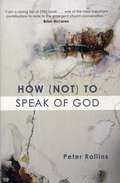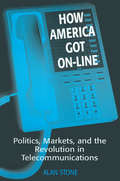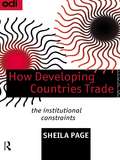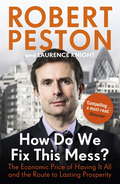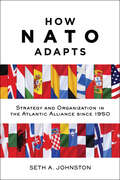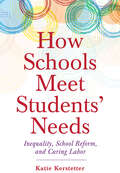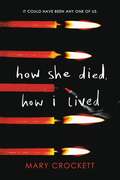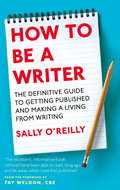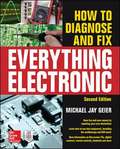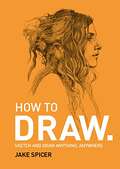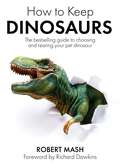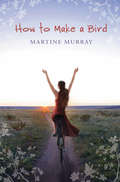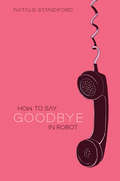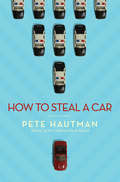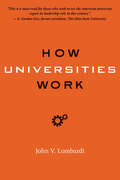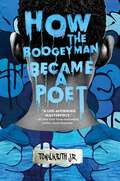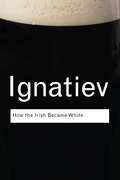- Table View
- List View
How (Not) to Speak of God
by Peter RollinsWith sensitivity to the Christian tradition and a rich understanding of postmodern thought, Peter Rollins argues that the movement known as the "emerging church" offers a singular, unprecedented message of transformation that has the potential to revolutionize the theological and moral architecture of Western Christianity.How (not) to Speak of God sets out to explore the theory and praxis of this contemporary expression of faith. Rollins offers a clear exploration of this embryonic movement and provides key resources for those involved in communities that are conversant with, and seeking to minister effectively to, the needs of a postmodern world. "Here in pregnant bud is the rose, the emerging new configuration, of a Christianity that is neither Roman nor Protestant, neither Eastern nor monastic; but rather is the re-formation of all of them. Here, in pregnant bud, is third-millennium Christendom." —Phyllis Tickle "I am a raving fan of the book you are holding. I loved reading it. I have already begun widely recommending it. Reading it did good for my mind and for my soul. It helped me understand my own spiritual journey more clearly, and it gave me a sense of context for the work I'm involved in. In fact, I would say this is one of the two or three most rewarding books of theology I have read in ten years." —Brian McLaren, from the Foreword
How AI Works: From Sorcery to Science
by Ronald T. KneuselAI isn&’t magic. How AI Works demystifies the explosion of artificial intelligence by explaining—without a single mathematical equation—what happened, when it happened, why it happened, how it happened, and what AI is actually doing "under the hood."Artificial intelligence is everywhere—from self-driving cars, to image generation from text, to the unexpected power of language systems like ChatGPT—yet few people seem to know how it all really works. How AI Works unravels the mysteries of artificial intelligence, without the complex math and unnecessary jargon.You&’ll learn: The relationship between artificial intelligence, machine learning, and deep learningThe history behind AI and why the artificial intelligence revolution is happening nowHow decades of work in symbolic AI failed and opened the door for the emergence of neural networksWhat neural networks are, how they are trained, and why all the wonder of modern AI boils down to a simple, repeated unit that knows how to multiply input numbers to produce an output number.The implications of large language models, like ChatGPT and Bard, on our society—nothing will be the same againAI isn&’t magic. If you&’ve ever wondered how it works, what it can do, or why there&’s so much hype, How AI Works will teach you everything you want to know.
How America Got On-line: Politics, Markets, and the Revolution in Telecommunication
by Alan StoneThe telecommunications industry is the fastest growing sector of the US economy. This interdisciplinary study of technopolitical economics traces the industry's evolution from the invention of the telephone to the development of hypercommunications. Primary focus is on AT&T and its rivals.
How Developing Countries Trade: The Institutional Constraints
by Sheila PageOver the last fifteen years there have been dramatic increases in both private and public intervention in international trade. Traditional barriers to market-based trade such as commodity cartels and tariffs have been augmented by new developments such as the rise of regional trade blocs and the growth of intra-firm trade. This book argues that the
How Do We Fix This Mess?
by Robert PestonIn Robert Peston's new book he explains in his characteristically straightforward way how the world got itself into the current economic mess - and how we might get out of it. 'How do we fix this mess? I don't know. But don't stop reading now. Perhaps if we have a clearer understanding of what went wrong, we'll have a better idea of what needs to be done. This book is a map of what needs to be fixed.' The record-breaking unbroken growth between 1992 and 2008 wasn't the economic miracle that it seemed. It was based on a number of dangerous illusions - most notably that it didn't matter that the UK and US year after year consumed more than they earned. But we couldn't go on increasing our indebtedness forever. The financial crash of 2007/8 and the subsequent economic slump in much of the west was the moment when we realised we had borrowed more than we could afford to repay. So who got it wrong? Bankers, investors and regulators? And were they greedy, stupid or asleep? What was the role of government? And what part did we, as consumers, play in all this? How do we get through this difficult period of transition to a more sustainable economy, one based on investment and exports, rather than on borrowing and consumption? With the same probing lucidity he brought to WHO RUNS BRITAIN?, Robert Peston takes us step-by-step towards a common sense way to fix this mess.
How NATO Adapts: Strategy and Organization in the Atlantic Alliance since 1950 (The Johns Hopkins University Studies in Historical and Political Science #132)
by Seth A. JohnstonDespite momentous change, NATO remains a crucial safeguard of security and peace.Today’s North Atlantic Treaty Organization, with nearly thirty members and a global reach, differs strikingly from the alliance of twelve created in 1949 to "keep the Americans in, the Russians out, and the Germans down." These differences are not simply the result of the Cold War’s end, 9/11, or recent twenty-first-century developments but represent a more general pattern of adaptability first seen in the incorporation of Germany as a full member of the alliance in the early 1950s. Unlike other enduring post–World War II institutions that continue to reflect the international politics of their founding era, NATO stands out for the boldness and frequency of its transformations over the past seventy years.In this compelling book, Seth A. Johnston presents readers with a detailed examination of how NATO adapts. Nearly every aspect of NATO—including its missions, functional scope, size, and membership—is profoundly different than at the organization’s founding. Using a theoretical framework of "critical junctures" to explain changes in NATO’s organization and strategy throughout its history, Johnston argues that the alliance’s own bureaucratic actors played important and often overlooked roles in these adaptations. Touching on renewed confrontation between Russia and the West, which has reignited the debate about NATO’s relevance, as well as a quarter century of post–Cold War rapprochement and more than a decade of expeditionary effort in Afghanistan, How NATO Adapts explores how crises from Ukraine to Syria have again made NATO’s capacity for adaptation a defining aspect of European and international security. Students, scholars, and policy practitioners will find this a useful resource for understanding NATO, transatlantic relations, and security in Europe and North America, as well as theories about change in international institutions.
How Not to Disappear
by Clare FurnissA pregnant teen and her gin sling loving great-aunt go on the journey of a lifetime in this &“absolutely gorgeous, heartfelt, and incredibly enjoyable&” (Robin Stevens, author of Murder Most Unladylike) novel that shows what happens when you&’re on the brink of losing everything.Our memories are what make us who we are. Some are real. Some are made up. But they are the stories that tell us who we are. Without them we are nobody. Hattie&’s summer is not going according to plan. Her two best friends have abandoned her: Reuben has run off to Europe to &“find himself&” and Kat is in Edinburgh with her new girlfriend. Meanwhile Hattie is stuck babysitting her twin siblings and dealing with the endless drama surrounding her mother&’s wedding. And she&’s also just discovered that she&’s pregnant with Reuben&’s baby. Then Gloria—Hattie&’s great-aunt who no one even knew existed—comes crashing into her life. Gloria&’s fiercely independent, rather too fond of a gin sling, and is in the early stages of dementia. Together the two of them set out on a road trip of self-discovery—Gloria to finally confront the secrets of her past before they are erased from her memory forever and Hattie to face the hard choices that will determine her future.
How Nuclear Weapons Spread: Nuclear-Weapon Proliferation in the 1990s
by Frank BarnabyIn How Nuclear Weapons Spread, Frank Barnaby examines the far-reaching effects - both beneficial and detrimental - of nuclear weapons. He looks in detail at the nuclear programmes of Third World countries, including India, Israel and Pakistan which have or could very rapidly acquire nuclear weapons, and assesses the nuclear capabilities of countries such as Iran, Iraq and North Korea. He also considers the alarming possibility that terrorists might obtain nuclear weapons, and considers methods of controlling their spread.
How Reform Worked in China: The Transition from Plan to Market
by Yingyi QianA noted Chinese economist examines the mechanisms behind China's economic reforms, arguing that universal principles and specific implementations are equally important. As China has transformed itself from a centrally planned economy to a market economy, economists have tried to understand and interpret the success of Chinese reform. As the Chinese economist Yingyi Qian explains, there are two schools of thought on Chinese reform: the “School of Universal Principles,” which ascribes China's successful reform to the workings of the free market, and the “School of Chinese Characteristics,” which holds that China's reform is successful precisely because it did not follow the economics of the market but instead relied on the government. In this book, Qian offers a third perspective, taking certain elements from each school of thought but emphasizing not why reform worked but how it did. Economics is a science, but economic reform is applied science and engineering. To a practitioner, it is more useful to find a feasible reform path than the theoretically best way. The key to understanding how reform has worked in China, Qian argues, is to consider the way reform designs respond to initial historical conditions and contemporary constraints. Qian examines the role of “transitional institutions”—not “best practice institutions” but “incentive-compatible institutions”—in Chinese reform; the dual-track approach to market liberalization; the ownership of firms, viewed both theoretically and empirically; government decentralization, offering and testing hypotheses about its link to local economic development; and the specific historical conditions of China's regional-based central planning.
How Schools Meet Students' Needs: Inequality, School Reform, and Caring Labor (Critical Issues in American Education)
by Katie KerstetterMeeting students’ basic needs – including ensuring they have access to nutritious meals and a sense of belonging and connection to school – can positively influence students’ academic performance. Recognizing this connection, schools provide resources in the form of school meals programs, school nurses, and school guidance counselors. However, these resources are not always available to students and are not always prioritized in school reform policies, which tend to focus more narrowly on academic learning. This book is about the balancing act that schools and their teachers undertake to respond to the social, emotional, and material needs of their students in the context of standardized testing and accountability policies. Drawing on conversations with teachers and classroom observations in two elementary schools, How Schools Meet Students’ Needs explores the factors that both enable and constrain teachers in their efforts to meet students’ needs and the consequences of how schools organize this work on teachers’ labor and students’ learning.
How She Died, How I Lived
by Mary Crockettp.p1 {margin: 0.0px 0.0px 0.0px 0.0px; font: 13.0px Times} Girl in Pieces meets The Way I Used to Be in this poignant and thought-provoking novel about a girl who must overcome her survivor's guilt after a fellow classmate is brutally murdered. I was one of five. The five girls Kyle texted that day. The girls it could have been. Only Jamie--beautiful, saintly Jamie--was kind enough to respond. And it got her killed. On the eve of Kyle's sentencing a year after Jamie's death, all the other "chosen ones" are coping in various ways. But our tenacious narrator is full of anger, stuck somewhere between the horrifying past and the unknown future as she tries to piece together why she gets to live, while Jamie is dead.Now she finds herself drawn to Charlie, Jamie's boyfriend--knowing all the while that their relationship will always be haunted by what-ifs and why-nots. Is hope possible in the face of such violence? Is forgiveness? How do you go on living when you know it could have been you instead?
How Societies Are Born: Governance in West Central Africa before 1600
by Jan VansinaLike stars, societies are born, and this story deals with such a birth. It asks a fundamental and compelling question: How did societies first coalesce from the small foraging communities that had roamed in West Central Africa for many thousands of years?Jan Vansina continues a career-long effort to reconstruct the history of African societies before European contact in How Societies Are Born. In this complement to his previous study Paths in the Rainforests, Vansina employs a provocative combination of archaeology and historical linguistics to turn his scholarly focus to governance, studying the creation of relatively large societies extending beyond the foraging groups that characterized west central Africa from the beginning of human habitation to around 500 BCE, and the institutions that bridged their constituent local communities and made large-scale cooperation possible.The increasing reliance on cereal crops, iron tools, large herds of cattle, and overarching institutions such as corporate matrilineages and dispersed matriclans lead up to the developments treated in the second part of the book. From about 900 BCE until European contact, different societies chose different developmental paths. Interestingly, these proceeded well beyond environmental constraints and were characterized by "major differences in the subjects which enthralled people," whether these were cattle, initiations and social position, or "the splendors of sacralized leaders and the possibilities of participating in them."
How To Be A Writer: The definitive guide to getting published and making a living from writing
by Fay Weldon Sally O'ReillyHow To Be a Writer is a comprehensive guide to the career of writing from experienced writer and creative writing tutor Sally O'Reilly.The book will cover questions such as: If you want to be a writer, should you invest in a creative writing course? If so, which one? Are writing groups a good thing? What grants, awards and prizes are available to the aspiring writer? How should you plan your career in the long term? It will also feature an introduction from Fay Weldon - 'Why I wish I'd read this book when I was 25' - and will include comments and case studies from other established authors, agents and industry experts. How To Be a Writer will include everything that a writer needs to know about running their own career, from choosing an agent to café scribbling, and from filing a tax return to flirting with the literati and will be an essential reference book for any author who takes their work seriously.
How To Diagnose And Fix Everything Electronic
by Michael Jay GeierRepair all kinds of electrical products, from modern digital gadgets to analog antiques, with help from this updated book. How to Diagnose and Fix Everything Electronic, Second Edition, offers expert insights, case studies, and step-by-step instruction from a lifelong electronics guru. Discover how to assemble your workbench, use the latest test equipment, zero in on and replace dead components, and handle reassembly. Instructions for specific devices, including stereos, MP3 players, digital cameras, flat-panel TVs, laptops, headsets, and mobile devices are also included in this do-it-yourself guide. Choose the proper tools and set up your workbench Ensure personal safety and use proper eye and ear protection Understand how electrical components work and why they fail Perform preliminary diagnoses based on symptoms Use test equipment, including digital multimeters, ESR meters, frequency counters, and oscilloscopes Interpret block, schematic, and pictorial diagrams Disassemble products and identify sections Analyze circuits, locate faults, and replace dead parts Re-establish connections and reassemble devices
How To Draw: Sketch and draw anything, anywhere with this inspiring and practical handbook
by Jake SpicerJake Spicer wants you to learn how to draw. This is his complete course in drawing, suitable for complete beginners as well as experienced artists, and designed to help you fit drawing into your lifestyle. Tried-and-tested exercises, ranging from five-minute sketches to dedicated sessions of an hour or longer, cover every subject and location you could wish for, while accessibly written drawing theory helps you relate the technical concepts to your practice, helping you to hone your craft. Whatever your goals are, expert art tutor Jake Spicer gives you the inspiration and encouragement to draw more - and keep improving.
How To Keep Dinosaurs: The perfect mix of humour and science
by Robert Mash'Who could resist a handbook about potential pets that has a little symbol for "likes children" and a separate one for "likes children to eat"... wonderful' GUARDIANHollywood and the popular press would have us believe that all dinosaurs are gigantic, hostile and untameable. In fact, there are many species that make charming and even useful companions: Velociraptor - a splendid, loyal, fierce, friendDeinonychus - will not eat dog food (dogs are another matter)Tyrannosaurus - least suitable to keep; will need special licenceOrnithomimus - an appealing first dinosaur for the child anxious for her first rideThis book advises you which dinosaur is right for you and your home, from the city apartment dweller looking for a lap pet, to the country estate owner looking to tighten up on security. HOW TO KEEP DINOSAURS is a bestselling guide, packed with the sort of information keen dinosaur keepers crave - from feeding and housing to curing common ailments, breeding and showing your animal. The author, a zoologist with extensive experience of dinosaurs, has provided a timely and much-needed source book for all those who keep dinosaurs and for the huge numbers who are contemplating getting one. It is as essential to every dinosaur keeper as a stout shovel and a tranquilliser rifle.
How To Make A Bird
by Martine MurrayA beautiful novel that captures the aching of a teenager ready to heal.It's dawn, on an empty road in the countryside. Empty, except for the girl in the long, red evening gown, standing next to a bicycle, and looking back at the home she's about to leave. Mannie's ready to start a new life and forget the terrible things that have happened here, but there are questions that need to be answered before she can let go. Questions about her elegant but unstable mother, her brother who's always overshadowed her, and his friend Harry Jacob, who just might be Mannie's boyfriend . . .
How To Run A Pop-Up Restaurant or Supper Club: Turn Your Passion For Food and Drink Into Profit
by Abigail Alldis William AlldisThis book is packed with everything amateur chefs need to know about delivering a pop-up restaurant. Including tips from the country's leading pop-up restaurateurs, the authors reveal everything from creating a menu, publicizing the event, dressing your venue, to running an organized kitchen. Discover how to: Theme your evening, and pick a fool-proof menu Organize front of house, and keep your customers happy Price your event and get free publicity Avoid licensing and health-and-safety pitfalls Guarantee your first pop-up is a roaring success Peppered with case studies from novices and professionals, you'll learn from other chefs' successes (and near-successes!) so your own evening runs without a hitch.
How To Run A Pop-Up Restaurant or Supper Club: Turn Your Passion For Food and Drink Into Profit
by Abigail Alldis William AldisThis book is packed with everything amateur chefs need to know about delivering a pop-up restaurant. Including tips from the country’s leading pop-up restaurateurs, the authors reveal everything from creating a menu, publicizing the event, dressing your venue, to running an organized kitchen. Discover how to:Theme your evening, and pick a fool-proof menuOrganize front of house, and keep your customers happyPrice your event and get free publicityAvoid licensing and health-and-safety pitfallsGuarantee your first pop-up is a roaring successPeppered with case studies from novices and professionals, you’ll learn from other chefs’ successes (and near-successes!) so your own evening runs without a hitch.
How To Say Goodbye In Robot
by Natalie StandifordFrom bestselling author Natalie Standiford, an amazing, touching story of two friends navigating the dark waters of their senior year.New to town, Beatrice is expecting her new best friend to be one of the girls she meets on the first day. But instead, the alphabet conspires to seat her next to Jonah, aka Ghost Boy, a quiet loner who hasn't made a new friend since third grade. Something about him, though, gets to Bea, and soon they form an unexpected friendship. It's not romance, exactly - but it's definitely love. Still, Bea can't quite dispel Jonah's gloom and doom - and as she finds out his family history, she understands why. Can Bea help Jonah? Or is he destined to vanish?
How To Steal a Car
by Pete HautmanFrom National Book Award winner Pete Hautman, the story of a girl who acts out by stealing cars.Some girls act out by drinking or doing drugs. Some girls act out by sleeping with guys. Some girls act out by starving themselves or cutting themselves. Some girls act out by being a bitch to other girls. Not Kelleigh. Kelleigh steals cars.In How to Steal a Car, National Book Award winner Pete Hautman takes teen readers on a thrilling, scary ride through one suburban girl's turbulent life - one car theft at a time.
How Universities Work (Higher Ed Leadership Essentials)
by John V. LombardiThe single best description of the inside workings of contemporary universities.Witty and insightful, How Universities Work is destined to be an essential handbook for anyone wanting to understand universities in the United States. John V. Lombardi gives readers an insider’s view of the academy, describing the structure, logic, dynamics, and operational styles of both public and private institutions of higher education. Lombardi defines and describes all the bits and pieces that compose a university with remarkable economy—from budgeting systems to tenure, from the library to the athletic field. Although focused on research universities, much of the discussion applies to other types of post-secondary institutions. Ideal for students, this book will form a solid foundation for courses in higher education, but it will also be a welcome addition to faculty and administrators’ personal libraries.
How the Boogeyman Became a Poet
by Tony Keith, Jr.Poet, writer, and hip-hop educator Tony Keith Jr. makes his debut with a powerful YA memoir in verse, tracing his journey from being a closeted gay Black teen battling poverty, racism, and homophobia to becoming an openly gay first-generation college student who finds freedom in poetry. Perfect for fans of Elizabeth Acevedo, George M. Johnson, and Jacqueline Woodson.Tony dreams about life after high school, where his poetic voice can find freedom on the stage and page. But the Boogeyman has been following Tony since he was six years old. First, the Boogeyman was after his Blackness, but Tony has learned It knows more than that: Tony wants to be the first in his family to attend college, but there’s no path to follow. He also has feelings for boys, desires that don’t align with the script he thinks is set for him and his girlfriend, Blu.Despite a supportive network of family and friends, Tony doesn’t breathe a word to anyone about his feelings. As he grapples with his sexuality and moves from high school to college, he struggles with loneliness while finding solace in gay chat rooms and writing poetry. But how do you find your poetic voice when you are hiding the most important parts of yourself? And how do you escape the Boogeyman when it's lurking inside you?
How the Irish Became White (Routledge Classics)
by Noel Ignatiev'…from time to time a study comes along that truly can be called ‘path breaking,’ ‘seminal,’ ‘essential,’ a ‘must read.’ How the Irish Became White is such a study.' John Bracey, W.E.B. Du Bois Department of Afro-American Studies, University of Massachussetts, Amherst The Irish came to America in the eighteenth century, fleeing a homeland under foreign occupation and a caste system that regarded them as the lowest form of humanity. In the new country – a land of opportunity – they found a very different form of social hierarchy, one that was based on the color of a person’s skin. Noel Ignatiev’s 1995 book – the first published work of one of America’s leading and most controversial historians – tells the story of how the oppressed became the oppressors; how the new Irish immigrants achieved acceptance among an initially hostile population only by proving that they could be more brutal in their oppression of African Americans than the nativists. This is the story of How the Irish Became White.
